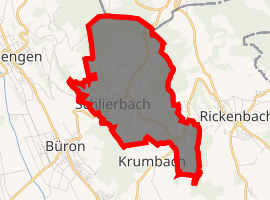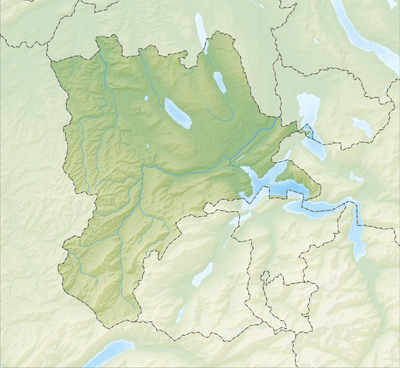Schlierbach, Switzerland
Schlierbach is a municipality in the district of Sursee in the canton of Lucerne in Switzerland.
Schlierbach | |
|---|---|
 Coat of arms | |
Location of Schlierbach 
| |
 Schlierbach  Schlierbach | |
| Coordinates: 47°13′N 8°7′E | |
| Country | Switzerland |
| Canton | Lucerne |
| District | Sursee |
| Area | |
| • Total | 7.23 km2 (2.79 sq mi) |
| Elevation | 697 m (2,287 ft) |
| Population (2018-12-31)[2] | |
| • Total | 889 |
| • Density | 120/km2 (320/sq mi) |
| Postal code | 6231 |
| SFOS number | 1100 |
| Surrounded by | Büron, Geuensee, Rickenbach, Schmiedrued (AG), Triengen |
| Website | www Profile (in German), SFSO statistics |
Geography
Schlierbach has an area of 7.2 km2 (2.8 sq mi). Of this area, 62.5% is used for agricultural purposes, while 31% is forested. The rest of the land, (6.5%) is settled.[3] In the 1997 land survey, 30.98% of the total land area was forested. Of the agricultural land, 57.68% is used for farming or pastures, while 4.84% is used for orchards or vine crops. Of the settled areas, 3.32% is covered with buildings, 0.14% is industrial, 0.41% is classed as special developments, 0.28% is parks or greenbelts and 2.35% is transportation infrastructure.
Demographics
Schlierbach has a population (as of 2007) of 632, of which 7.8% are foreign nationals. Over the last 10 years the population has grown at a rate of 7.7%. Most of the population (as of 2000) speaks German (95.2%), with Albanian being second most common ( 3.0%) and French being third ( 0.5%).
In the 2007 election the most popular party was the FDP which received 39% of the vote. The next three most popular parties were the CVP (31.3%), the SVP (21%) and the Green Party (4.2%).
The age distribution in Schlierbach is; 163 people or 25.1% of the population is 0–19 years old. 186 people or 28.7% are 20–39 years old, and 208 people or 32% are 40–64 years old. The senior population distribution is 71 people or 10.9% are 65–79 years old, 17 or 2.6% are 80–89 years old and 4 people or 0.6% of the population are 90+ years old.[4]
In Schlierbach about 64.2% of the population (between age 25-64) have completed either non-mandatory upper secondary education or additional higher education (either university or a Fachhochschule).
As of 2000 there are 183 households, of which 34 households (or about 18.6%) contain only a single individual. 34 or about 18.6% are large households, with at least five members.[4] As of 2000 there were 140 inhabited buildings in the municipality, of which 86 were built only as housing, and 54 were mixed use buildings. There were 74 single family homes, 9 double family homes, and 3 multi-family homes in the municipality. Most homes were either two (66) or three (15) story structures. There were only 4 single story buildings and 1 four or more story buildings.[4]
Schlierbach has an unemployment rate of 0.9%. As of 2005, there were 93 people employed in the primary economic sector and about 37 businesses involved in this sector. 14 people are employed in the secondary sector and there are 8 businesses in this sector. 31 people are employed in the tertiary sector, with 9 businesses in this sector.[3] As of 2000 53.4% of the population of the municipality were employed in some capacity. At the same time, females made up 38.3% of the workforce.
In the 2000 census the religious membership of Schlierbach was; 487 (85.9%) were Roman Catholic, and 25 (4.4%) were Protestant. There are 18 individuals (3.17% of the population) who are Muslim. Of the rest; there were 21 (3.7%) who do not belong to any organized religion, 16 (2.82%) who did not answer the question.[4]
References
- "Arealstatistik Standard - Gemeinden nach 4 Hauptbereichen". Federal Statistical Office. Retrieved 13 January 2019.
- "Ständige Wohnbevölkerung nach Staatsangehörigkeitskategorie Geschlecht und Gemeinde; Provisorische Jahresergebnisse; 2018". Federal Statistical Office. 9 April 2019. Retrieved 11 April 2019.
- Swiss Federal Statistical Office accessed 24-Aug-2009
- LUSTAT Lucerne Cantonal Statistics Archived 2011-11-27 at the Wayback Machine (in German) accessed 12 August 2009
| Wikimedia Commons has media related to Schlierbach. |